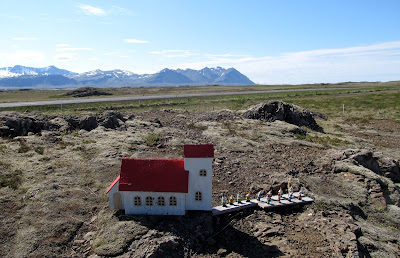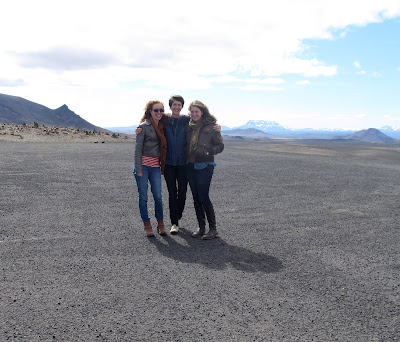
Time is a strange thing. I feel like I’ve been in some kind of strange
paralysis as of late, with clocks ticking far too slowly and, simultaneously, far too quickly.
I haven’t seen darkness in over
three weeks. I had underestimated how much this affects life on daily basis. In some
ways, it’s amazing. Days feel long and full of possibilities; there is less pressure to accomplish anything, and a remarkably relaxed, vacation vibe around town. But it’s also incredibly disorienting. Sometimes it makes me feel like I'm living in some kind of time warp. I sleep differently
here and my dreams are strange, hovering somewhere too close to reality. Every night I fall asleep with an airplane eye mask over my
eyes that I inevitably find tangled in my sheets in the morning.
This is what my midnight looks like.
In some ways, the last few weeks
have felt like a never-ending Groundhog Day. The light affects this, of course,
but I’m also living in an environment that keeps repeating itself. I adore my
Reykjiavk apartment, but I am its most permanent resident. There are three
bedrooms and all are rented out on an almost nightly basis. My landlady (a wonderful person who has turned into a great resource for my research and whose twenty-three year-old daughter has become a friend), was
willing to give me a big discount because I’m staying here so long, but it
means that every day or two, the people I share the apartment with changes.
On a daily basis I hear people fiddling with the
stubborn outdoor lock and come to the door to help them in. We shake hands and
my ears adapt to their accents: Italian, Canadian, French. We have the same
conversations. It's so weird that it really doesn't get dark at all. I read in the guidebook that people
here eat rotten shark. Have you been to the Blue Lagoon? I am a witness to
all of these strangers’ adaptations to Iceland, their journeys, their plans, their discoveries, their conversations on a loop. And then it's over. We talk about leaving. Do
you know how to get to the bus station from here? How early do you think I
should get to Keflavik before my flight? How often are the Flybuses?
Then they pack up and leave.
I’m still here.
Eleven months later.
It means almost everyday I have a
constant reminder that the end is near. It means I’ve been thinking about which Flybus I will take to the
airport on July 27th for weeks now. It means I know the route to the
bus station by heart.
All of these people are coming and
going around me, and I am coming to terms with a strange kind of permanence by
comparison. And yet in the grand timeline of this year, it's really only fleeting. It is only just beginning to hit me what a change this year’s
ending will be, and how this change is much more than just a geographical one.
I’ll be returning to the states and I’ll be giving up this opportunity, and, perhaps most jarringly, an identity.
I don’t know how many times in the
last year I have introduced myself. The words I have used to do so will be
lost to me in less than a month's time. I will stop describing myself as a traveler, an American, a student, a person doing research, a person studying names. I will be moving about the world under different titles, and I'm not sure what words will fill those spaces.
People keep asking me if I’m ready
to settle, if I’m looking forward to going home so that I can be in one place
for a while. The answer is yes. I want to settle, I want to be in one place for
a while. I desperately want to unpack my bags and stop wasting money at the
grocery store buying things I don’t like because I can’t understand what it
says on the packaging. But home actually isn't really settling for me. I’ll be in Vermont for a few weeks or months and then will probably uproot myself again for Philadelphia or New York or some other city where
I miraculously might find someone who wants to pay me to do something. The words I'm using to describe myself will most likely keep changing not only when this experience is over, but over and over again for the next few years.
Icelandic Independence Day
I wish I could say I was having the
best month ever, but in light of all of this, and the fact that I pretty much
have no money left, I’ve been having a strange sort of hermiting few weeks, spending a lot of time in my apartment and drinking many cups of tea,
venturing out for interviews or afternoons in coffee shops or walks by the water.
Counter-intuitively, I
think my last month is going to be one of my hardest. I’m feeling a bit burnt
out; a bit tired of my topic, a bit tired of meeting people I know I will be
saying goodbye to in a short amount of time. It's hard to know if this is a
product of eleven months of making connections and then breaking them, or if I
feel this way because, on a sub-conscious level, I know the end is right
around the bend. Time is strange that way too.
.JPG)
It is hard to throw yourself into things when you know they are so temporary.
I was talking to a friend the other day and we were talking about how this
might not even be a product of a Watson-year as much as it is a product of
being in your twenties; putting so much of yourself into places and relationships and jobs
and opportunities that will most likely slip away again.
That doesn’t mean they’re not worth
having in the first place, but it does mean that at this juncture I feel like I’m
performing some sort of strange Watson-senioritis balancing act, one foot here, one
foot in the uncertain future.
I know I’ll go home and I’ll miss
these streets, I’ll miss these people. I’ll
miss introducing myself in the same way I have been for the last eleven months, even if these introductions lead too quickly to goodbyes.
In the last month I have:
-Seen an Irish faerie ring.
-Fed a Connemara pony.
-Witnessed a flash mob with dozens of colorful
umbrellas.
-Taken a ferry to the Aran Islands and ridden in a
pony trap around Inish Mor.
-Visited the Neolithic ruins of Dun Aonghasa
-Said
goodbye to my parents (again).
-Met with members of the Irish Traveling community.
-Set foot in a new country (Iceland!) for the first
time.
-Learned how to say thanks and cheers in Icelandic.
(Do you need any other words?)
-Stumbled upon gnome houses and elf rocks.
-Seen more waterfalls than I ever have.
-Had three straight weeks of sunlight nights.
-Planned and completed a road trip around the country
with two dear friends.
-Visited beaches laden with icebergs.
-Watched geysirs erupt.
-Climbed volcanoes, hiked glaciers, examined craters,
collected rocks.
-Seen an infinite number of sheep.
-Gotten to drive
(for the first time since January). Windows down, sun shining, music playing.
-Eaten bone marrow.
-Rented a car for the first time in my life.
-Visited a museum devoted to phalluses. (Also have
been supremely weirded out by the fact Icelandic stores sell condoms that come
in “regular” AND “extra safe” varieties).
-Swam in a geothermal pool.
-Stood at the continental drift between the North
American and Eurasian tectonic plates.
-Created a music video.
-Received the gift of Watson-year flash cards. And an
all-American snap bracelet. (Nothing
says “America” quite like a snap bracelet).
-Marched in a parade for Icelandic Independence Day.
-Bought an Icelandic sweater.
-Knit elbow patches for said Icelandic
sweater.
-Patiently received instruction from
the Handknitting Association of Iceland about how to make my first piece that
involved changing colors. (Mittens are in the works).
-Met a Watson Fellow from the class of
1981.
-Tried (harder than I would like to
admit) to be as fashionable as Icelanders.
-Spent weekend mornings perusing old
record collections, used clothing, and fish products at the Kolaportið Flea
Market.
-Smelled like sulfur every time I took
a hot shower.
335 days down, 30 days to go. There's a kind of poetry in that, I think.





















































